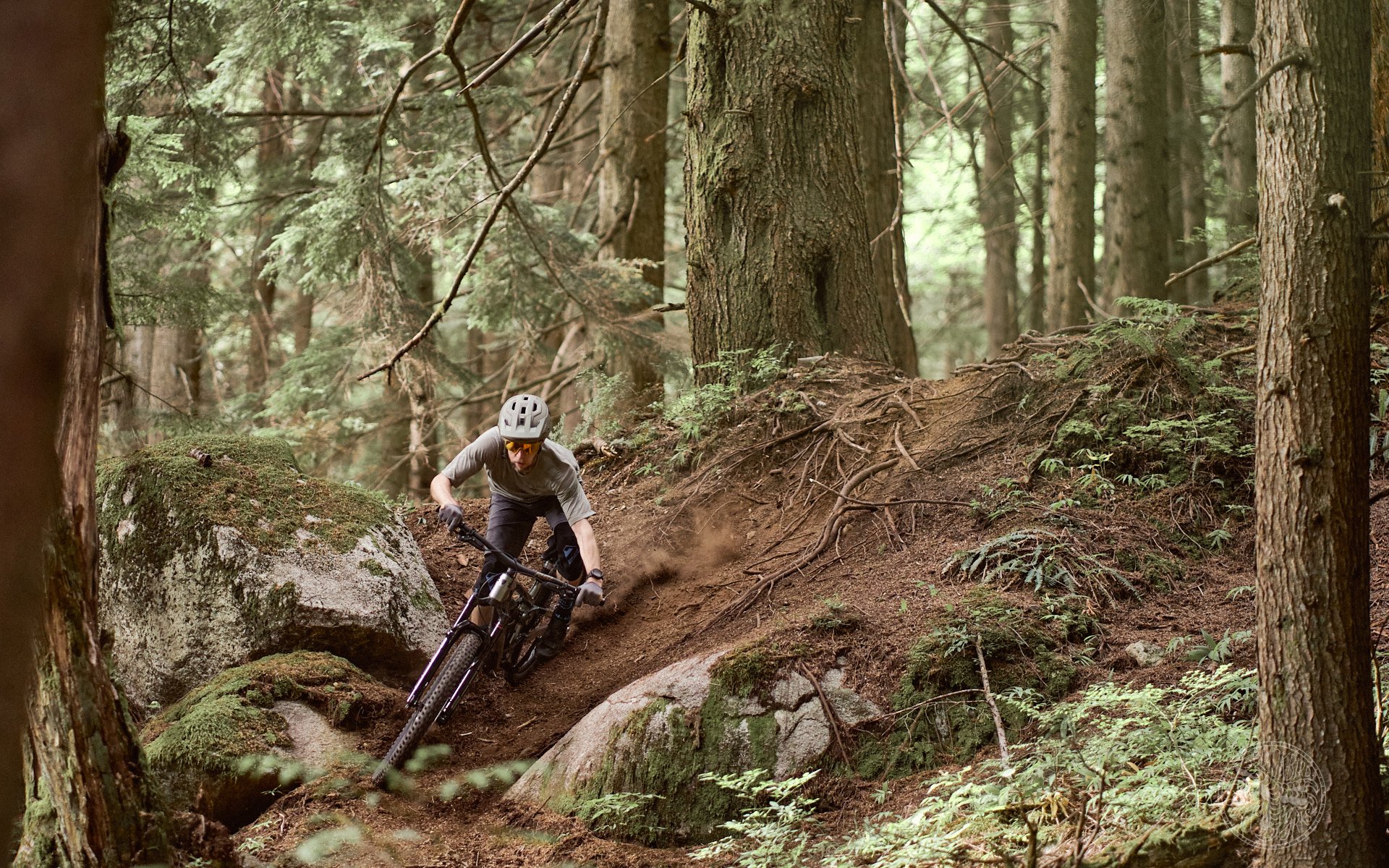
First Ride
Trek Slash: The Next Generation
Regular readers here at nsmb dot com will know a couple things: we typically don’t just regurgitate press releases for new bikes, and we do two-part reviews with a ‘first look’ and a long term follow up. This gets build specs, geometry, and other technical details along with some early riding impressions out in a timely fashion, and then a deep dive into the ride and any long-term issues or livability pros and cons in the full review. Those early ride impressions typically come from a week or three of sneaking around on bikes that don’t exist yet, parking away from all the usual hangouts, and never leaving secrets around where prying eyes (and cameras) might spot them. Sometimes this is made easy; brand identity being what it is, often a new bike won’t look too different from others in the range and a bike can hide in plain sight. Sometimes, people try and chase you down because your Chromag has rear suspension and is bright gold.
You’d expect the former option to be the case with a new Trek. After all, it just looks like a Session, right? Unfortunately, the problem here – with the Gen 6 Trek Slash 9.9 XO AXS T-Type – is just that. It looks like a Session: high pivot, idler pullies, and all. How the hell was I going to hide this thing? Fortunately this problem was solved for me when a big brown Trek Project One box showed up a mere 36 hours before the bike inside explodes across the internet and into a bike shop near you. That means the ride impressions here will be ‘limited’. But let’s dive in, have a look, and then we’ll circle back later this fall and we’ll see if this novelty-sized-idler equipped mullet bruiser has won me over.
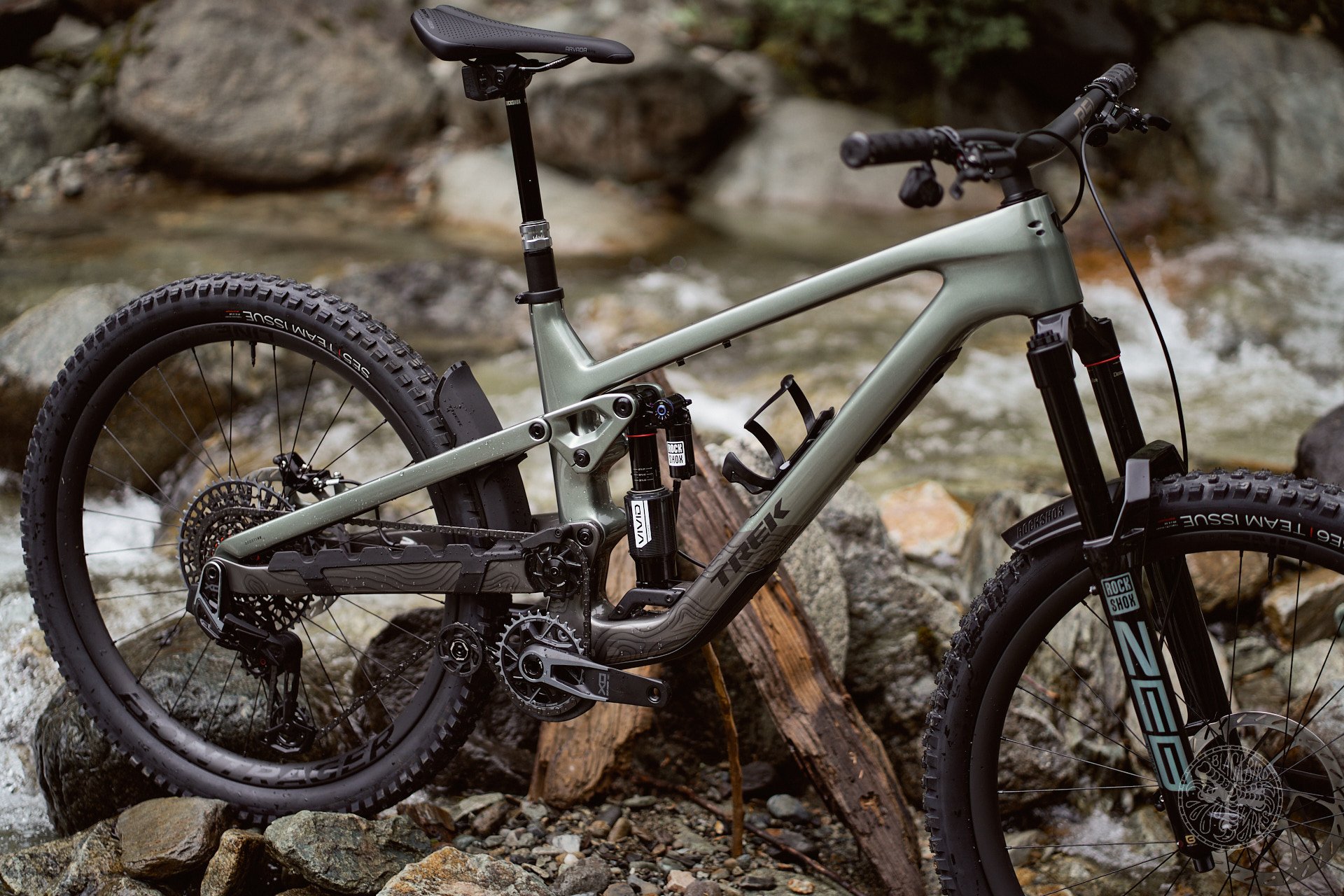
Subtle colours can't hide the drastic change in profile from the old Slash here.
Highlights
- High pivot, with idler(s)
- 170mm at both ends
- Slacker than previous Slash, with option for +/- 1º with drop-in headset cups
- Stock mullet - all sizes come in 29/27.5 F/R except for small, which is 27.5 only
- Can be converted to 29/29
- Integrated fender, shuttle guards, and downtube protection layer
- Fits longer droppers than previous
- Adjustable leverage rate, and bottom bracket height
Frame changes and details
Temporarily overlooking the biggest change here - the two enormous idler pulleys and main pivot point several inches above where it used to be - a lot of details on the new frame are worth a mention. The previous iteration was designed as a 29"-wheeled bike with the option for mullet. This is now reversed and everything but size small ships with mixed wheels. There's replaceable downtube protection, along with an integrated fender, and aggressively large chain and seatstay protection (remember that, it comes up later).
Gone is the Mino Link, but for the Geometron-Curious there's the ability to change the shock leverage rate, the head tube angle by a degree in either direction with cups, as well as bottom bracket height with a new lower shock mount. Amusingly to me, it has neither Trunnion mount or knock block. Trek was a big part of why modern Trunnion mount exists, however I'm not a big fan so I see its omission as a plus for customers. Steering angle concerns be dammed, I am a knock block fan. So between the two, it's a wash.
The new frame fits much longer dropper posts across all sizes which many folks will appreciate, but sadly the official word from Trek on dual crown forks is, "They will fit, but we haven’t tested them, so we cannot recommend a dual crown fork on Slash at this time." Usually, this means the impact protection where stanchion bumpers would contact the frame is not adequate.
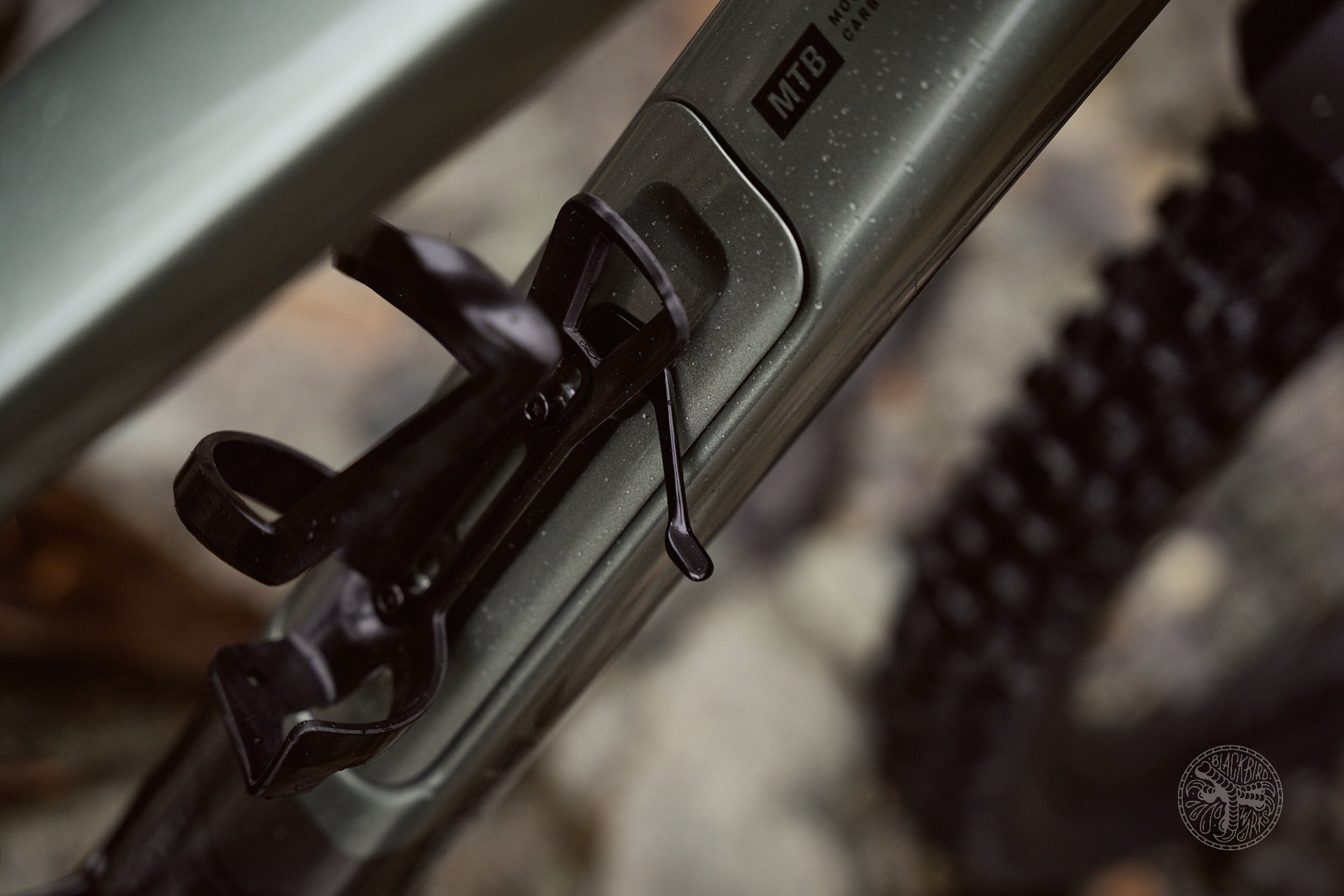
Downtube storage - the seal has been improved over the Top Fuel I reviewed previously.
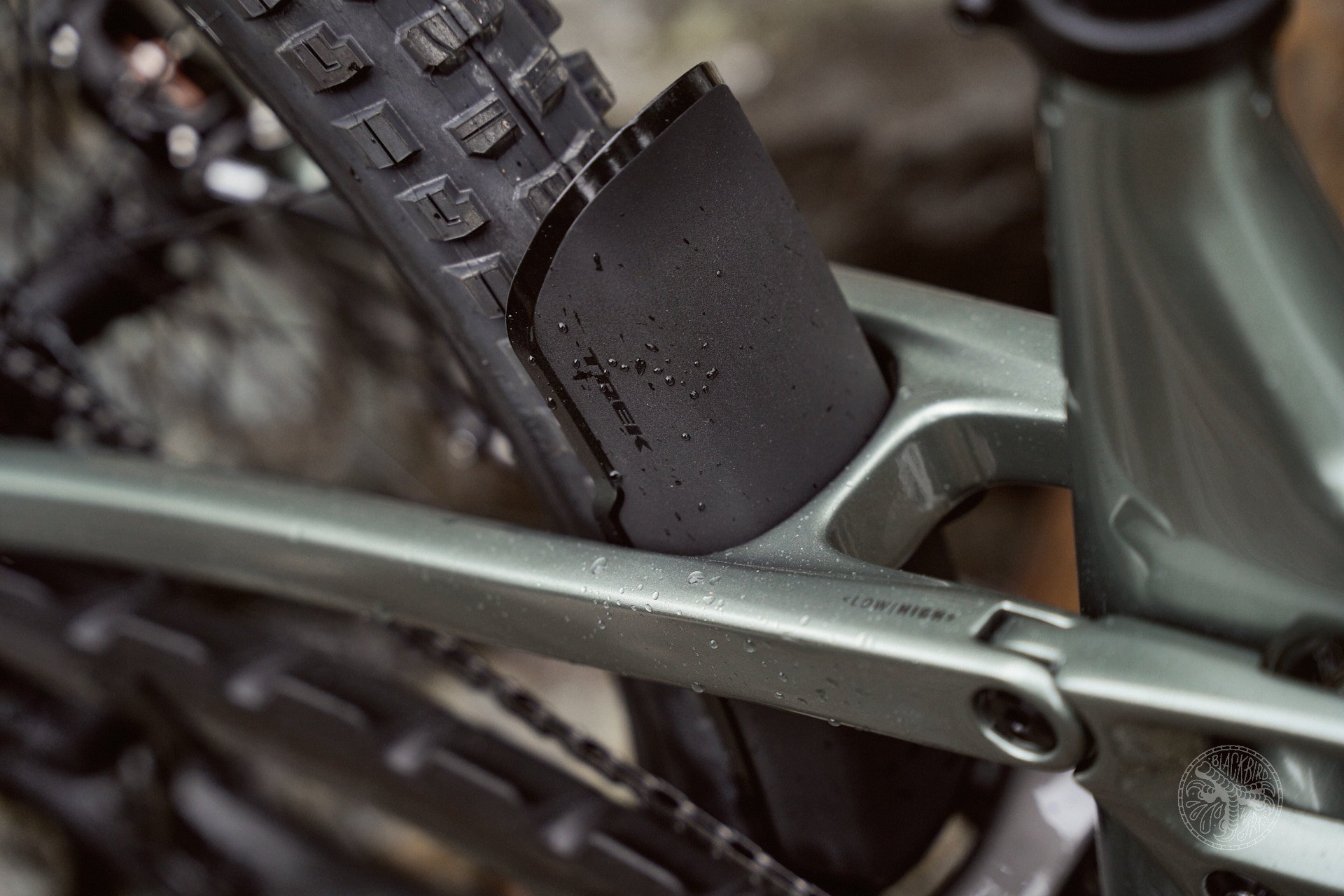
Bolt on fender guards are meant to match aesthetics of bolt on fork fenders. This no longer fits should you choose to swap to a 29" rear wheel.
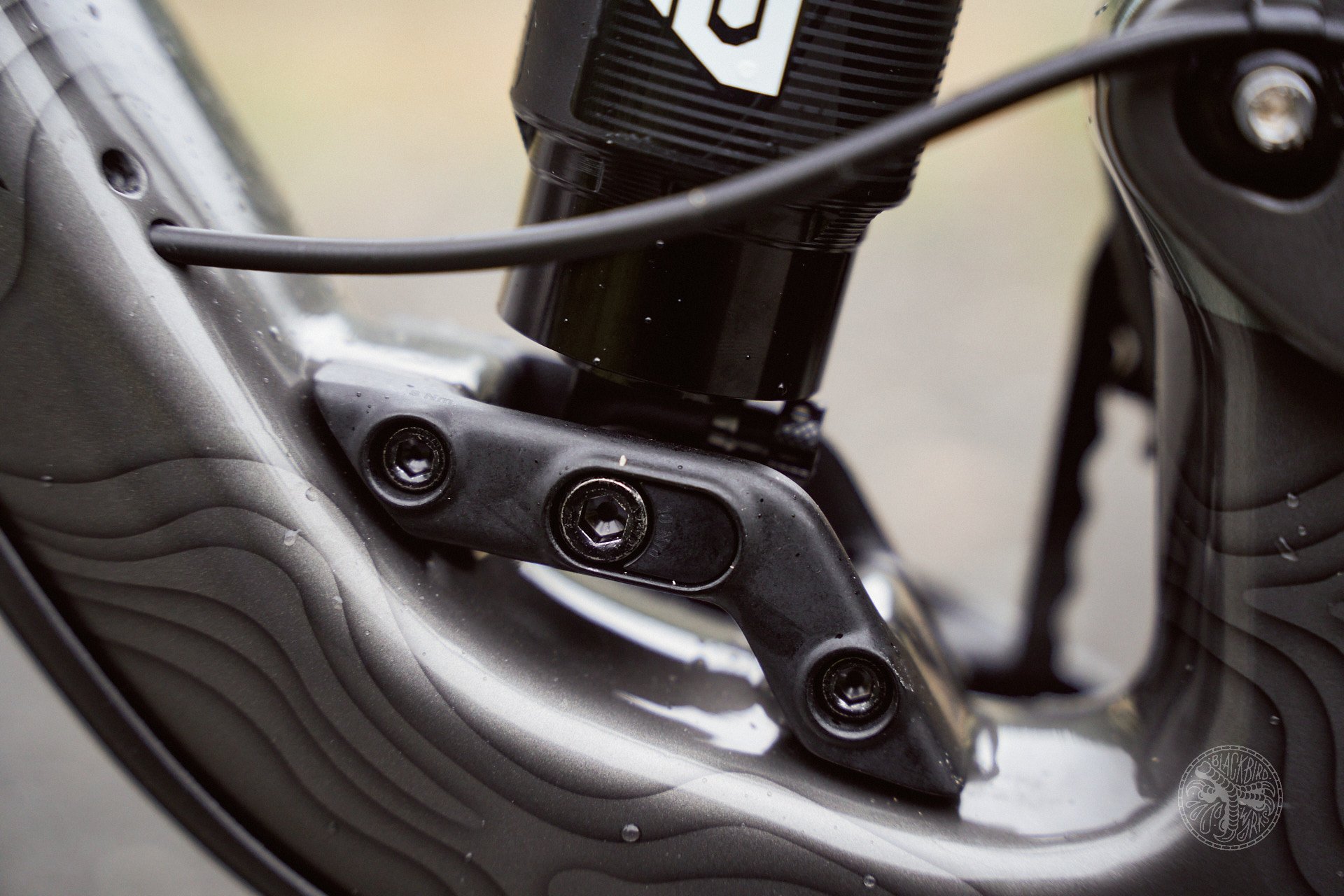
Adjustable lower shock mount to change between leverage ratios. If you want to swap to a 29" rear wheel, you can purchase a new lower mount to preserve geometry. Both mounts are included if you buy frame only. Cable routing is tidy.
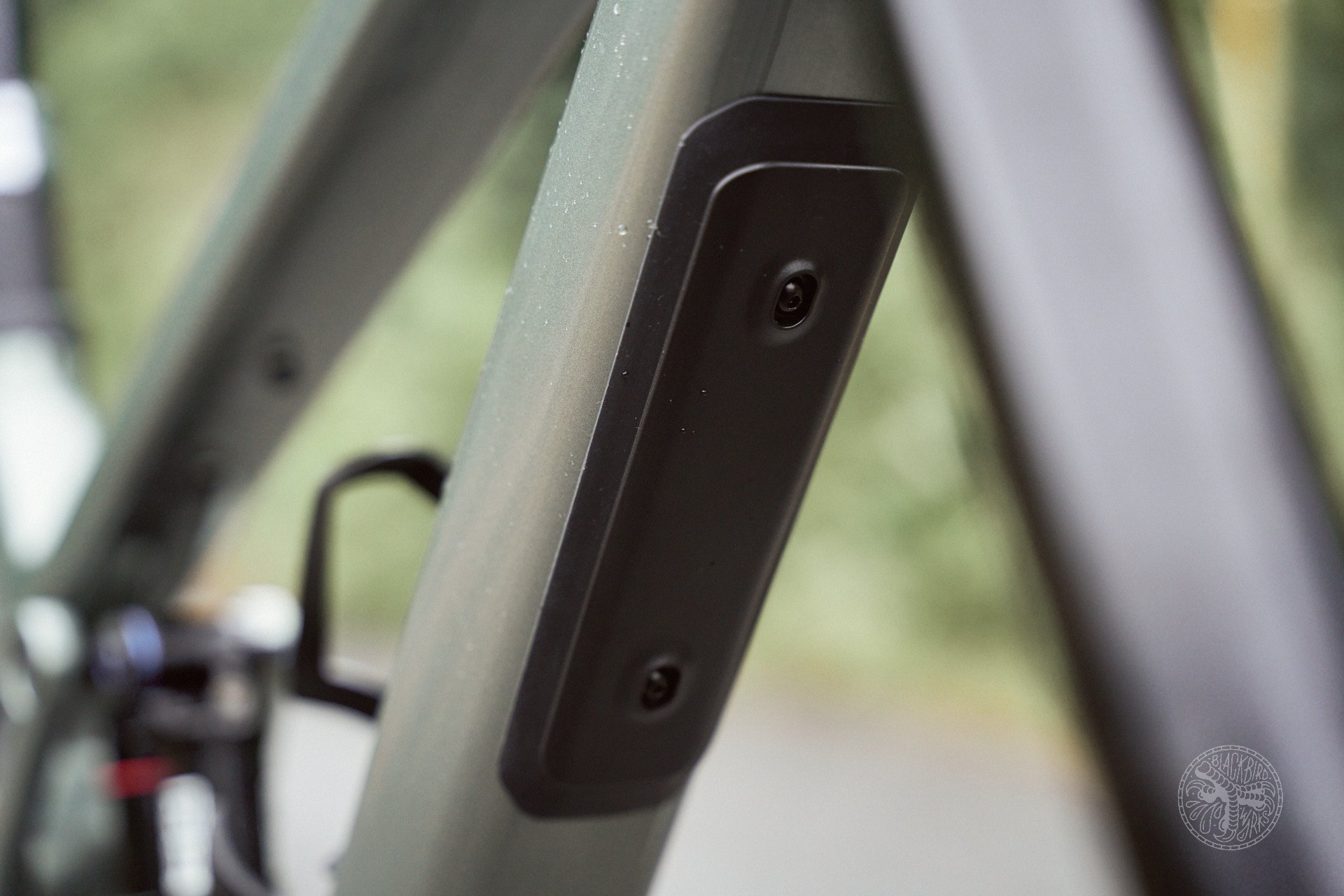
Both the shuttle guard and guard around the bottom of the downtube are removable. The downtube itself is also protected with a thermoplastic layer under the paint on carbon frames.
Two Enormous Idlers / Raised Pivot
Clearly the biggest change is the switch to a high pivot idler suspension design like the current Session. On the Slash they're different, more efficient (read: enormous) idlers, but the concept is the same as it's always been; the upper idler reduces kickback and keeps anti-squat values the same through travel, and the lower idler reduces chain length changes and minimizes loads on the derailleur clutch from suspension movement and vice versa. The four-link rear end still uses Trek's split-pivot design where chain and seat stays join at the rear axle in an effort to separate braking forces from suspension, but overall the main pivot is miles from the previous Slash.
Seriously though, these pulleys are both enormous. This is an effort to improve efficiency as wrapping chains around small cogs adds tremendous drag (this is why almost no one makes 9t cogs for real pedaling, why your drivetrain is significantly more efficient towards the big end of your cassette, and why companies like Garbaruk sell huge jockey wheels).
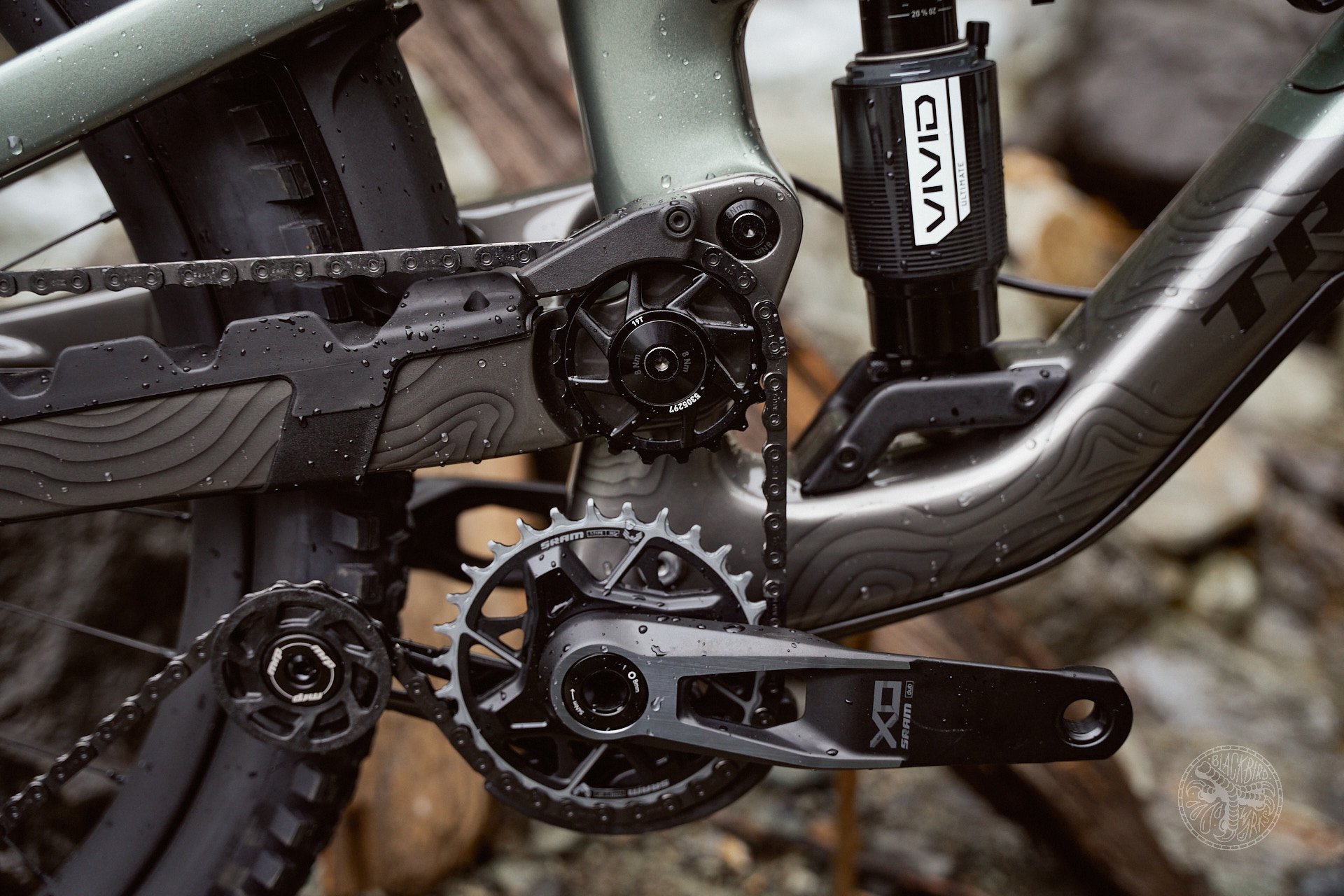
The biggest changes are all here - high pivot and two idlers. The bike retains Trek's ABP split pivot out back. It's hard to overstate how much bigger these are than the idlers on most bikes.
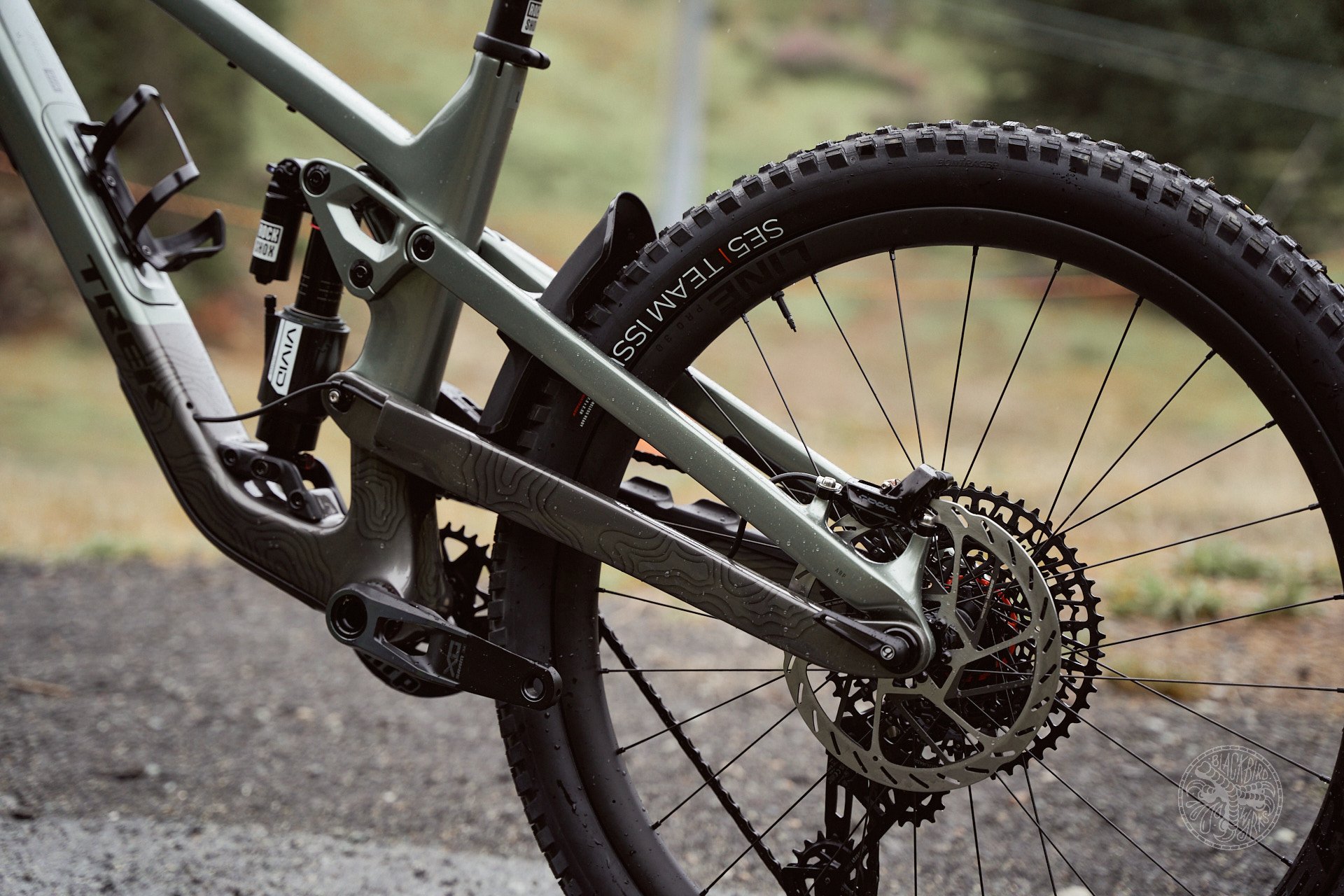
The pivot point changes are almost more obvious from the non-drive side, unobscured by pulley wheels.
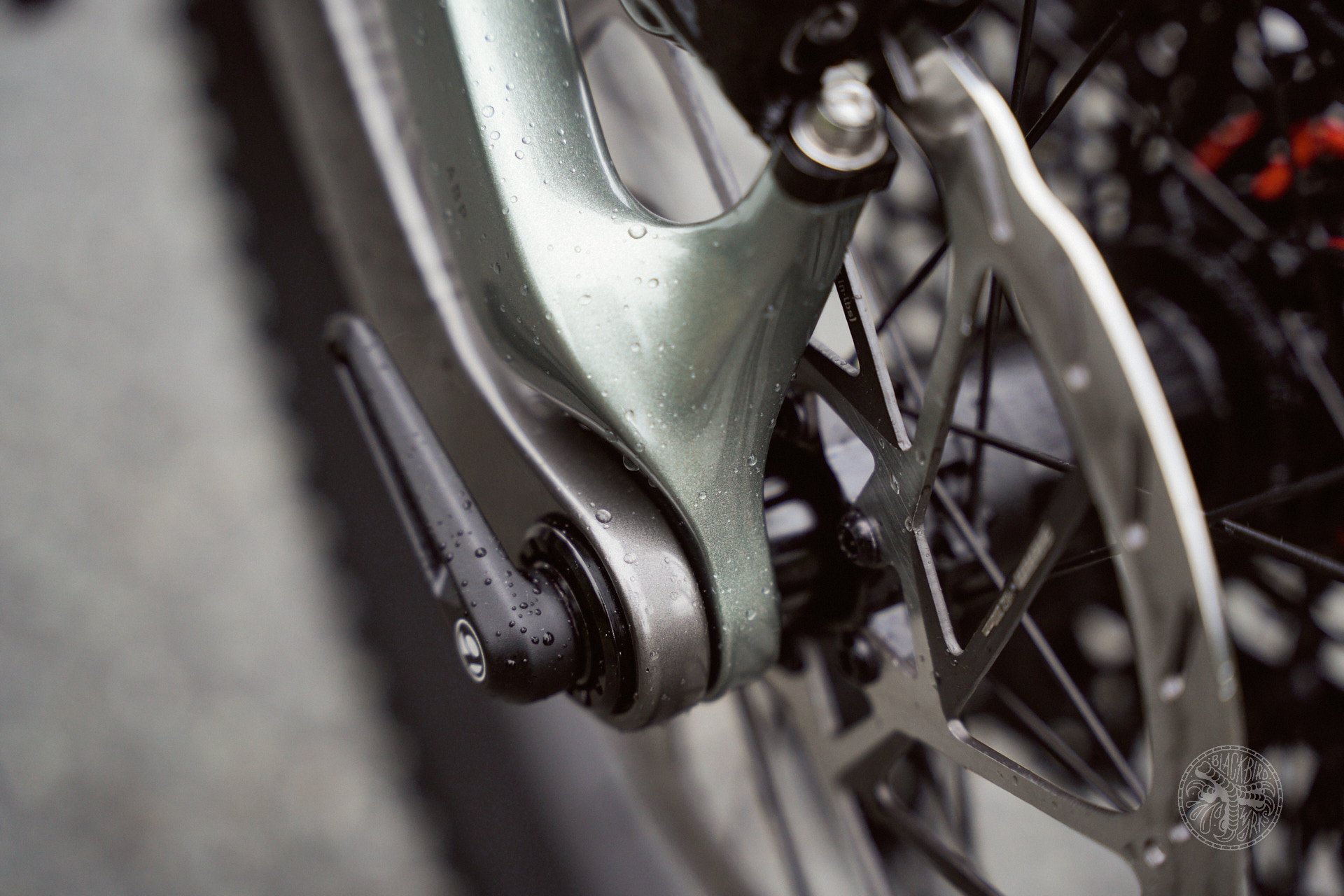
As you'd expect, there's a split pivot out back. 200mm is the minimum rear rotor size.
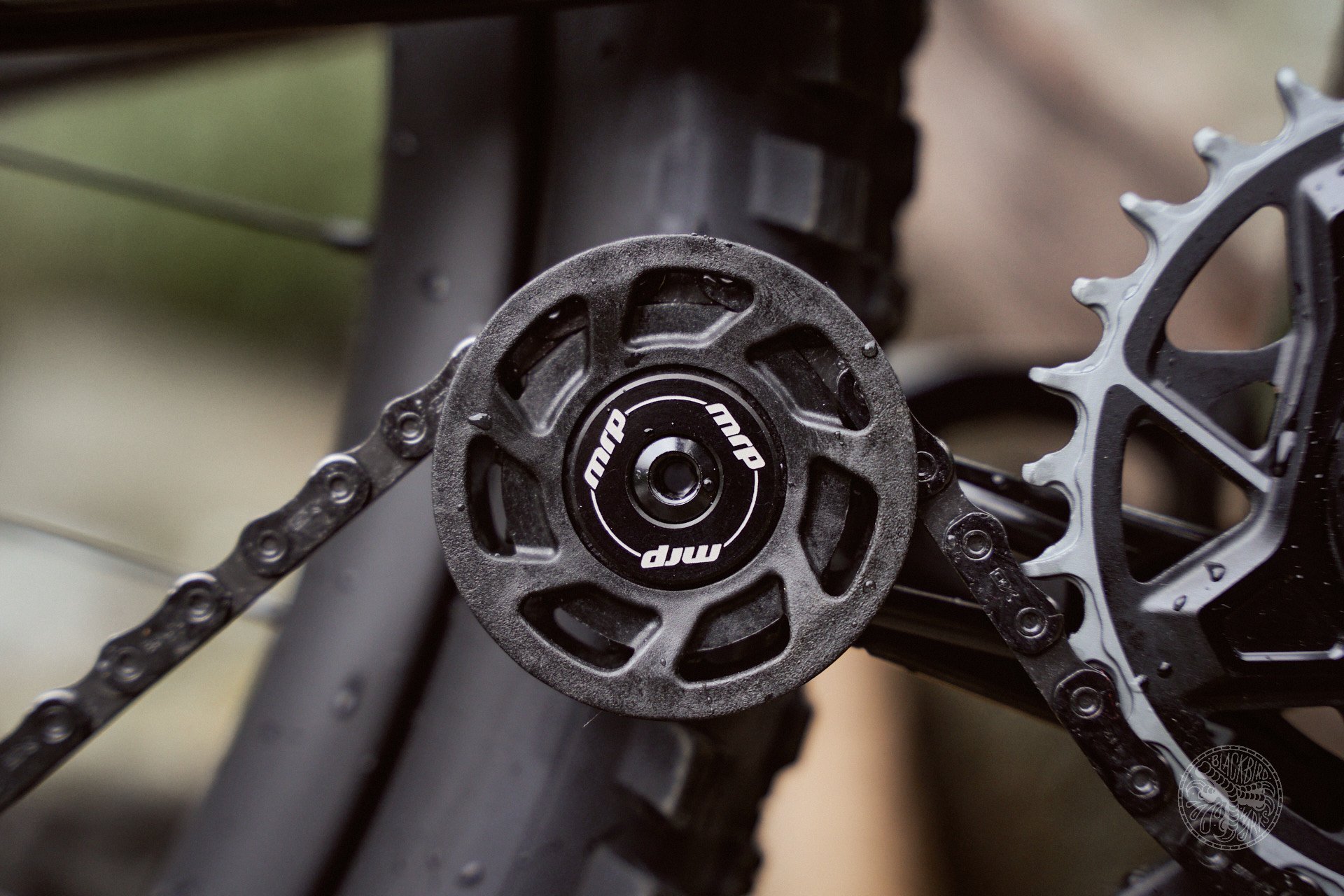
THIS. SHOULD. BE. BRIGHT. ORANGE.
Geometry
| 15.5 - S | 17.5 - M | 18.5 - ML | 19.5 - L | 21.5 - XL | |
|---|---|---|---|---|---|
| Wheelsize (F/R) | 27.5/27.5 | 29/27.5 | 29/27.5 | 29/27.5 | 29/27.5 |
| Reach | 430 | 448 | 468.1 | 488.1 | 513.2 |
| ETT | 547.5 | 577.8 | 605.4 | 627.9 | 658.1 |
| Seattube | 390 | 400 | 420 | 435 | 470 |
| STA | 74 | 73.8 | 73.8 | 73.8 | 73.8 |
| ESTA | 78.1 | 77.8 | 77.3 | 77.1 | 76.7 |
| Stack | 587.7 | 623.1 | 632.1 | 641.1 | 659 |
| Headtube | 100 | 100 | 110 | 120 | 140 |
| HTA | 63.5 | 63.3 | 63.3 | 63.3 | 63.3 |
| BB Height | 351.5 | 351.1 | 351.1 | 351.1 | 351 |
| BB Drop | 10 | 27 | 27 | 27 | 27 |
| Chainstay | 429 | 429.2 | 434.2 | 434.2 | 439.2 |
| Wheelbase | 1195.1 | 1223.8 | 1253.2 | 1277.7 | 1311.6 |
| Standover | 727 | 766 | 766 | 767 | 768 |
The stock geometry isn't crazy for 2023, but it's clearly built to plow. At 5'10" and change, I've gone for the M/L* size as it's closest to my preferred reach number. All of these numbers change a bit once you start adjusting headset cups, changing bottom bracket height with shock mounts, etc, but I'll spare you the pages and pages of charts supplied in the media kit. Pleasantly, the chainstay length changes across the size range; there's only two rear ends (carbon, and aluminum), but each size has the main pivot placed differently to balance fore-aft length around the bottom bracket.
*I kinda love that Trek still lists sizes with seat tube inch measurements like "18.5"
Build kits and spec
Trek sent me a 9,400 US (12,000 CAD) 9.9 XO AXS T-Type build replete with a carbon frame, wheels, and one-piece handlebar, powered by SRAM’s latest XO1 Transmission drivetrain, and sprung with things that say “Ultimate.” Park rats and those with more reasonable budgets will be pleased to know there are options down to $4,400 (5,650 CAD). For this, you get an alloy... sorry “Alpha Platinum Aluminium” frame and Fox/XT build. You can also have your Alpha Platinum Aluminum frame with Transmission, in a Slash 9 build ringing in at 5,800 US (7,450 CAD) with GX T-Type, Code Brakes, and a Zeb/Vivid Select+ combo. If I were putting down my own money here, I’d be hard pressed to go above this option given the bike's intent, but I wish it came with Ultimate dampers.
The rest of the options are all RockShox-suspended, carbon-framed varieties topping out at $11,500 (14,900 CAD), in either SRAM or Shimano complete gruppos. You can also go frame and shock only, if you’re still building bikes from the ground up (and if you are, awesome).
So far my only real spec complaint is the 30t front chainring. Given the 52t cassette and small rear wheel, this is too small for me. I get that the idea here is probably that the bike isn't a climbing machine and it's just there to get you back to the top, but it means I'm routinely in much higher gears than I'd like to be with more chainslap and noise, and anything over 30km/h leads to comical crank RPM.
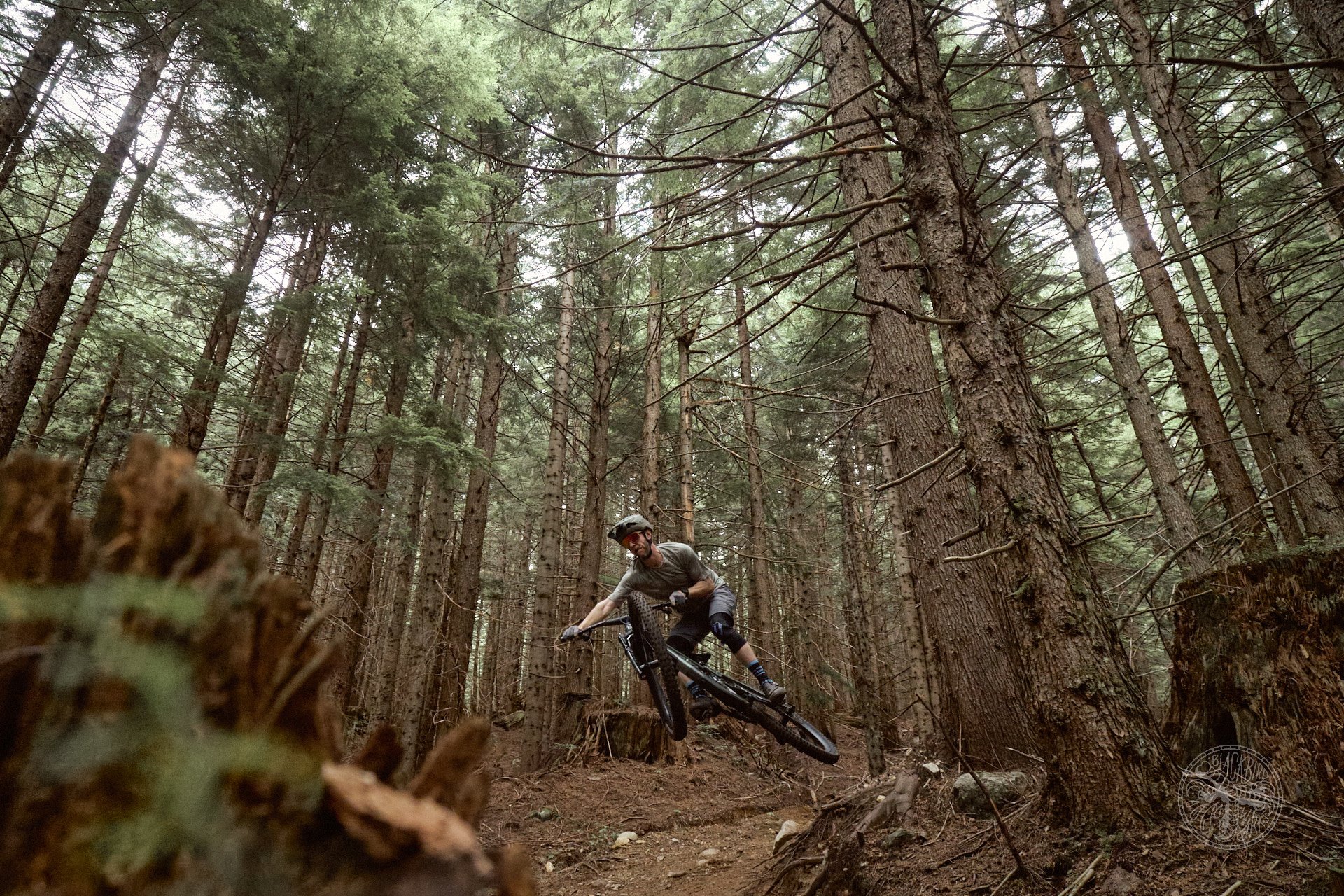
Instead of pictures of components you've seen like T-Type, Stealth Code Brakes, and a Zeb with Dave's favourite Buttercups, lets use this photo and I'll mention the new RockShox Vivid rear shock that comes spec'd on all builds, and how hard maneuvering anything with an 820mm bar is.
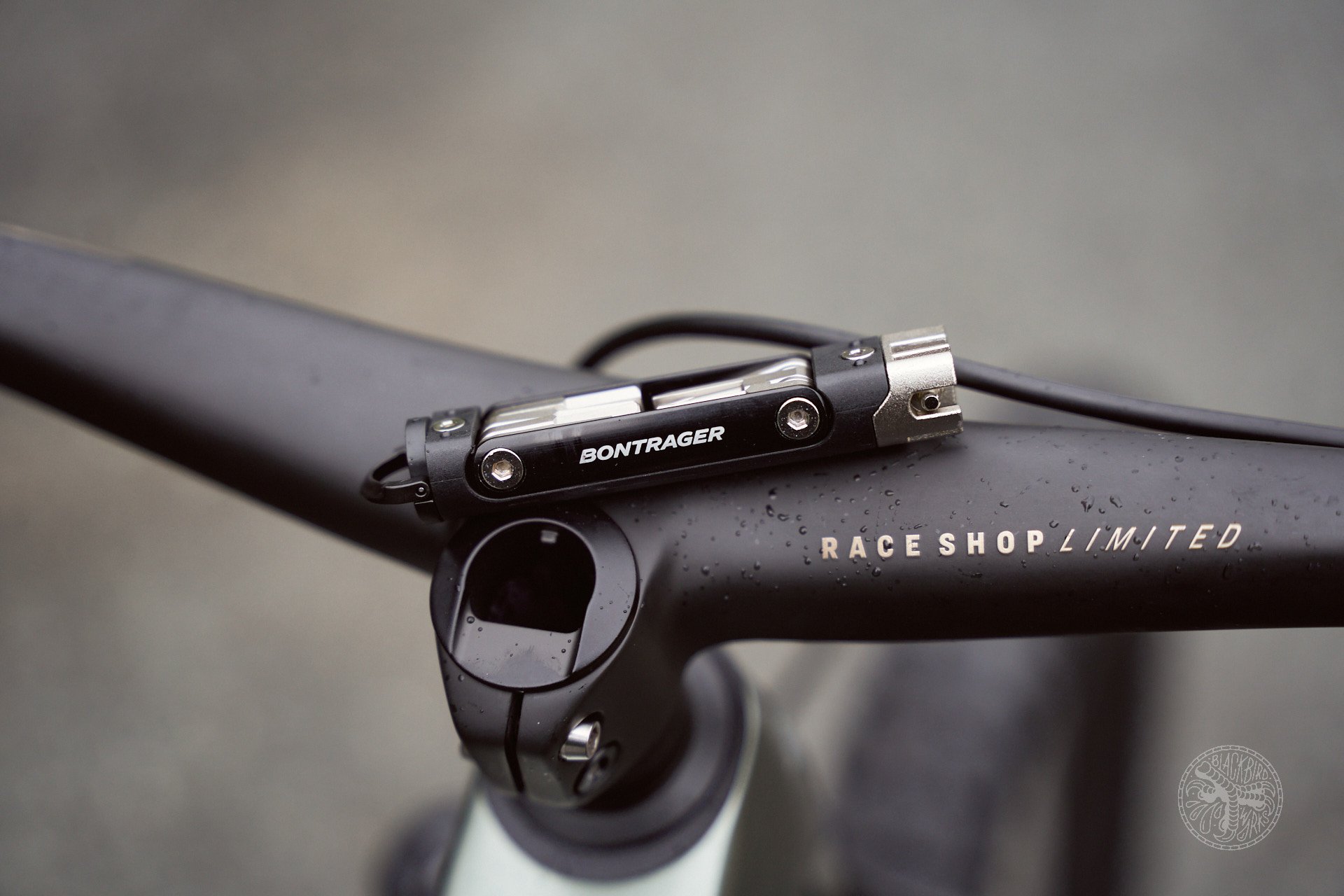
The included multi-tool actually looks like a really nice one - it even includes a chain tool. It does make headset setup a bit fiddly. Deniz and I agree that these bars are odd looking but perform well; he reviewed them here and I've previously used them on the Top Fuel.
Riding the Slash
As you probably gathered from the intro, I don't have heaps of time on this bike yet. I have one ride which was a mix of shakedown and photos. Despite both requiring a fair bit of faff, one requires you to be on top of your game and one usually means you're at the bottom. I was absolutely at the bottom - trying to get comfortable on something drastically different than my personal We Are One Arrival 170 and without enough ride time recently.
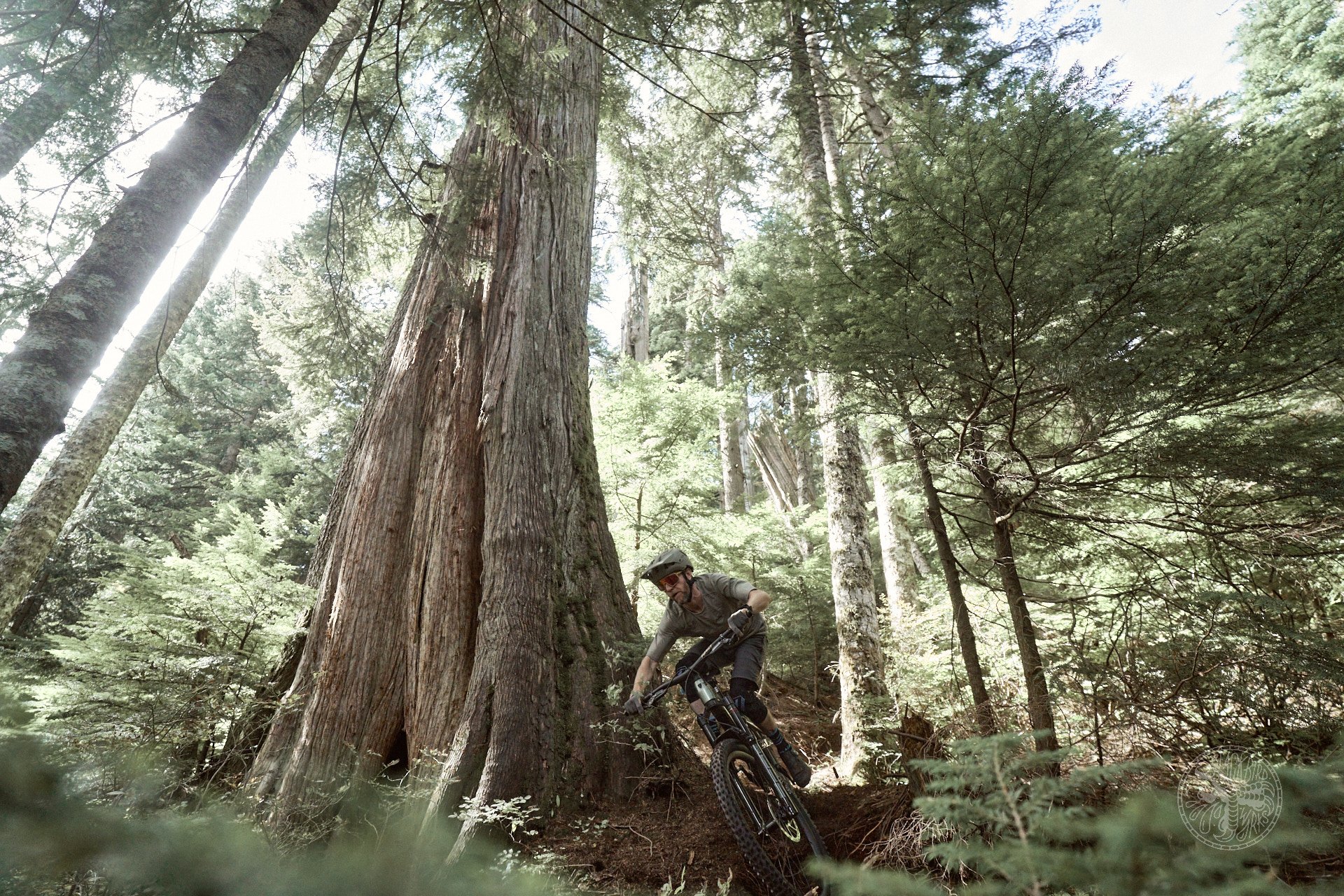
It's more awkward for me than you - I just hacked my way through this day of shooting. Kudos to Deniz for working with mediocre light and a worse rider.
But we learned some things, and there's a lot I'm excited to get dialed in and spend some time on.
- It's not a climbing monster, but it seems pretty acceptable. I'm curious to see how everything wears in, how the idlers fare in sh*tty weather, and if it's a bike I actually want to pedal places.
- The pulleys do add noise. Also, in the 10t, the chain rubs on the chainstay and seatstay guards and it sounds like you're riding with Alvin and the Chipmunks.
- I need to find a balance with the suspension. Currently it's super supple and plush, running around 28% sag out back, but I'm regularly using more travel than I'd like (the HBO does mean there's no harsh bottom outs, though). Moving air volume around between the Vivid and Zeb should help here.
- Once I get this suspension tuned, it's definitely a bike that wants to go fast and isn't concerned by rough stuff. Y'know that pull, where the landing is a bit of a minefield? It'll be fine. Give'r a yank.
- There's a lot of geometry and kinematics options, I'm not sure if I care.
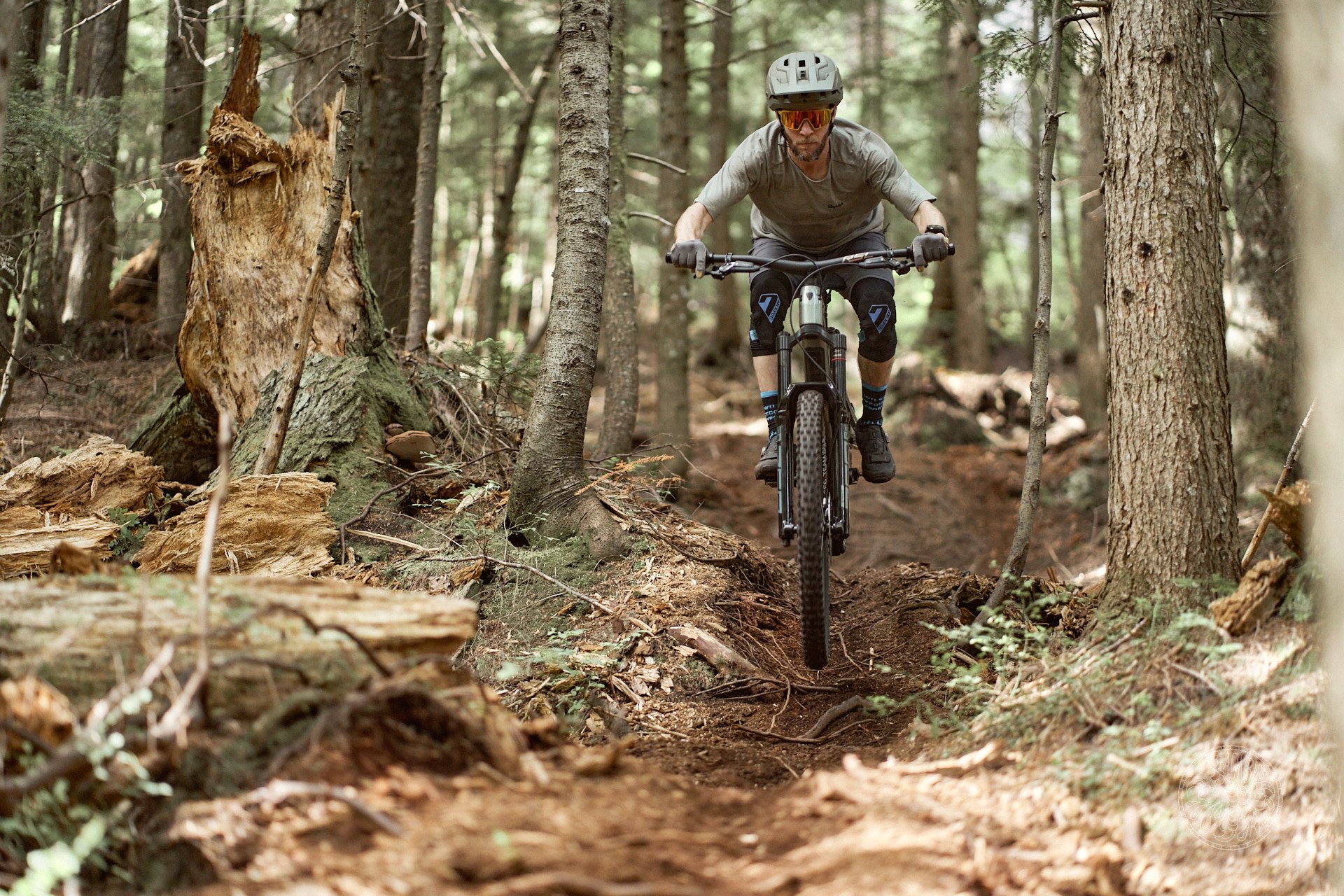
Straight lines and big holes? Just let go of the binders and let the Slash do the rest. Yes, that face means I'm having fun.
So who is this bike for? So far, I'd say its someone who can't justify a downhill bike because they do a fair bit of pedaling, but also wants something that'll keep up with the crew shuttling, and isn't afraid of the bike park. It's skewed deeply to the end of gnarly trails and steep lines, and loves to eat up the rough stuff. I'm keen to get comfortable, and see if the bike pushes me. I expect I'm going to spend a fair bit of time riding this thing in a full face helmet. I'll report back.
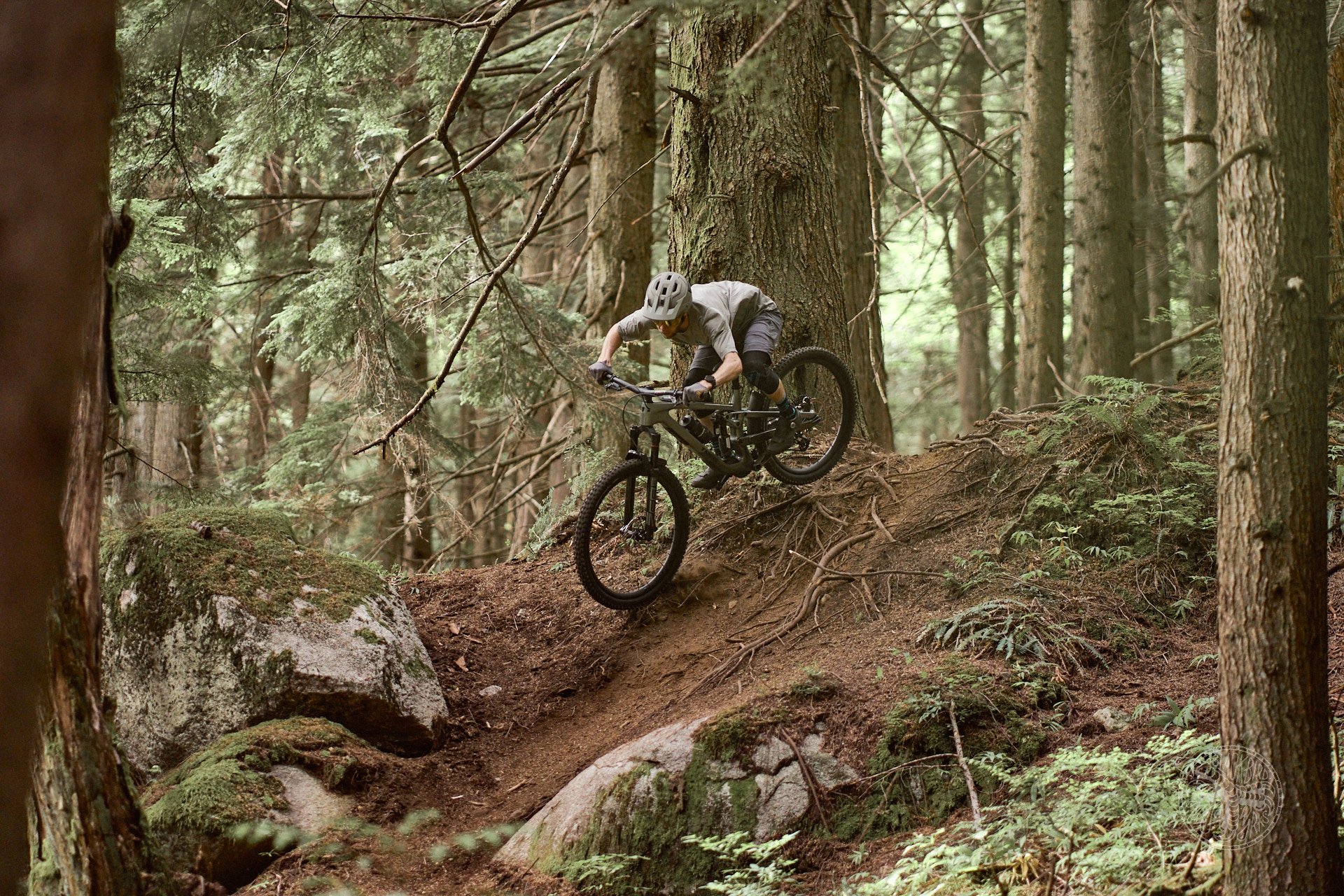
Still working to find a balance between both ends of suspension - and good lord the 820mm bars make a lot of things impossible. They'll see a hacksaw immediately.
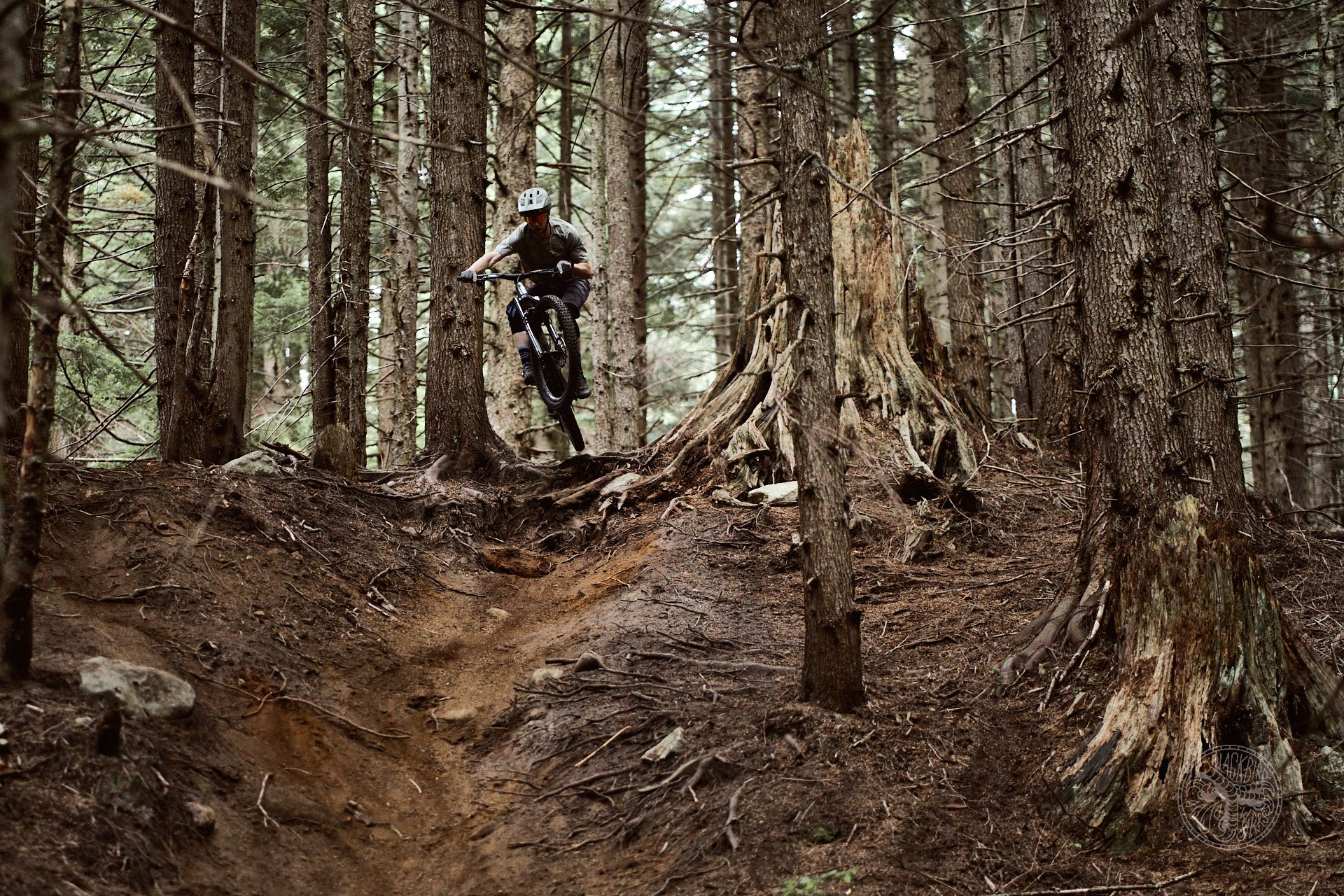
I'm excited to dig this thing into some more corners, point it down some steep things, and land things that are a lot uglier than this.
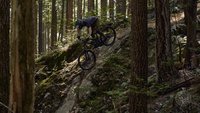

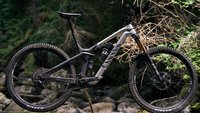
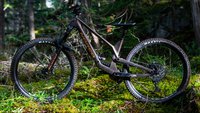
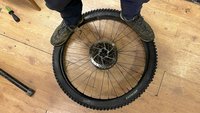

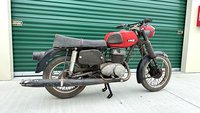

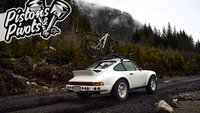
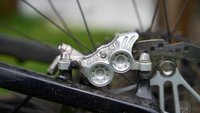

Comments
Glenn Bergevin
8 months ago
It blows my mind the chain rubs in the 10t. Smacks of designing line to line in CAD and not thinking about the real world.
Reply
Cooper Quinn
8 months ago
Yep, I am sure it fits on the computer screen
But I dont ride in Autocad...
Reply
Justin White
8 months ago
Maybe it was just designed without fully accounting for the Transmission chain line slash cassette position...
Reply
BarryW
8 months ago
While the spacing out from the wheel might be different, any sprocket on the cassette will have the same height regardless of that so long as the tooth count is the same. Meaning a 20 tooth will always be the same distance off the axle center (so height off the chainstay in this case) no matter the specific drivetrain.
So it's a bigger oops than would be expected from a brand like Trek. Not to mention the Druid making that same mistake on V1.
Reply
Cooper Quinn
8 months ago
Its a function of the chainstay position on a high pivot bike like the Slash (or v1 Druid), the clearance is always going to be tight - the only way to offset the chain from the chainstay is a larger idler (which has kinematic impacts). Basically that bar of the suspension is the same as the chainline.
Reply
Timer
7 months, 4 weeks ago
One would expect a brand like Trek, who aren’t new to this „carbon“ thing, to be able to build a narrower or offset chainstay.
Reply
Cooper Quinn
7 months, 4 weeks ago
Where are you offsetting it to? Narrower doesn't solve the geometry challenge?
Justin White
7 months, 3 weeks ago
@Cooper, offsetting it to somewhere out of the way of the chain. Timer's point was that carbon parts don't have to run in straight lines or be the same size throughout, and Trek claims to be one of the best at carbon, so they surely could play around with funky shaped and angled tubes to get the clearance they needed.
Or perhaps they just valued aesthetics over quietness and durability...
BarryW
7 months, 3 weeks ago
So make it a dropped stay.
We see this a lot on 'normal' bikes where the chainstay drops a lot from it's pivot point before heading to the rear axle. Simple enough.
Reply
hotlapz
8 months ago
It's even dumber when you have Forbidden make this mistake first on the v1 Druid.
Reply
Cooper Quinn
8 months ago
See above comment.
Reply
kamloops_rider
7 months, 4 weeks ago
And on the Dreadnought and on the V2 Druid but on the other end of the cassette
Reply
Jerry Willows
8 months ago
Ultimate suspension on the GX model would be the ticket.... are the calipers the new ones?
Curious on why the pivots are higher up on enduro bikes than on dh bikes.
Reply
Perry Schebel
8 months ago
it'd be interesting to a/b the conventional bike (assuming the geo is similar enough). curious if the added weight (~1kg), mechanical complexity, drag, differences in chassis dynamics, etc, are suitably offset by the (purported) improvement in chunder munching (esp. on a pedally bike application).
Reply
Cooper Quinn
8 months ago
I have a power meter but you'd have to pay me a lot more to go do real pseudo-science like that.
Reply
Kenneth Perras
8 months ago
The going joke in some circles is that the idler adds 7lbs (in reference to the Norco Range).
Unfortunately when you add complexity, such as extra pivots, idlers, longer chains, storage, fancy tube shapes, etc, the weight goes up.
No shade being thrown here; the Range gets good reviews and this new Trek looks polished.
Reply
Cooper Quinn
8 months ago
This is the heaviest bike I've ridden in some time.
It doesn't seem to pedal too poorly, but I'll find out with more data if it's actually slower up the hills.
What the breakdown between weight/drag there is... I probably won't be able to determine reliably. And tires.
Reply
handsomedan
7 months, 1 week ago
Will you be able to ride it with a 29" rear wheel? Curious to know how that changes the climbing and descending. Also curious to know how it compares to the Range. Loam Wolf likes Slash > Range.
Reply
Justin White
8 months ago
There aren't any more pivots than the last version. How do fancy tube shapes add weight?
Reply
Tim Coleman
8 months ago
I've got a Norco Range and a Transition Spire that are very similar in travel and geometry. The Range has a coil shock, and a heavier frame that nets out to it being 4 pounds heavier. I've done a bunch of back to back rides from 1 to 4 hours on both bikes and found that the rides are no faster on the lighter Spire, and if anything I finish the bigger 1,500 m Eagle rides fresher on the Range than the Spire. I thought maybe the wheels / tires were a contributor, so did a back to back double lap on Burnaby Mountain as fast as possible over about an hour, and the time between the Spire and Range were within a minute on the same wheels and tires with my heart rate being overall lower on the Range. It's far from scientific, but I think the chunder munching improvements far outweigh the idler drag and mechanical complexities (for the Range at least).
Reply
Cooper Quinn
8 months ago
Yeah w/o using a power meter its... pretty much just conjecture.
Reply
Justin White
8 months ago
Relative heartrate is a decent indicator of functional power output. And drivetrain power meters don't measure any of the other power put into the bike when descending from the rest of the body.
So a power meter can only tell you if it costs anything extra to climb, while overall HR (and internal fun-o-meter) might tell you if that cost is worth it. Sounds like it is worth it for Tim.
Reply
Onawalk
7 months, 3 weeks ago
What length cranks, and chainring on the Spire?
I have a Spire as well, went from a V1 Sentinel. Spire really had me gassed on climbs that were no fuss at all on the Sentinel, I chalked it up to the smaller chainring, and shorter cranks (I was spinning faster for the same speed, seems I ride to a certain trail speed rather than a certain cadence)
I did find I liked being onut on longer rides on the Spire, and have done bigger days in the saddle.
I went back and fourth between the Spire and Range before I settled on the Spire, the Range felt like more of a dog on the climbs to me....ymmv
Reply
Onawalk
8 months ago
I'm just curious if youve spent any time on HP, idler equipped bikes?
No shade, just curious based on your use of "purpoted"
Reply
Perry Schebel
7 months, 3 weeks ago
i've had lots of time on hp dh bikes (gearbox & jackshaft platforms), but haven't tried any of the current short(er) travel platforms. i'm pretty familiar with the potential benefits of a hp, but they've also not been without tradeoffs, and the trek pivot isn't *that* high, so a bit curious of the cost/benefit ratio in comparison to a standard configuration.
Reply
Onawalk
7 months, 3 weeks ago
Everything has tradeoffs, theres no magic bullet for a suspension platform.
I spent some time on the Range, prior to buying the Spire, that Range just swallowed everything in its path, it blew me away.
Ive tried to ride as many different bikes as I can, I seem to feel most comfortable on the typical horst link platforms (Norco, Transition, etc)
I'm very curious to try the new Druid, theres just something about the HP/idler that I think will be a tonne of fun on a shorter travel bike.
Reply
Cooper Quinn
8 months ago
Agreed on build kit. As it says in the copy, the bike is equipped with Code Stealth Silver.
Reply
Justin White
8 months ago
Hmm, I think the upper pulley isn't technically an "idler". An idler usually transmits no force, but that one kind of does: the seat stay is pulled down by chain tension via the upper pulley. The bottom is truly an idler: only guides the chain. This applies to most all iTrack type designs where the idler is not fixed relative to the cranks. Perhaps a better, more technically accurate name could help some folks intuit how the idler effects the suspension...
Reply
cshort7
8 months ago
Unless you have a 1:1 gear ratio with the idler or chainring mounted concentric to the IC (which would be possible with a jack-shaft system a la Starling, or a concentric single pivot), the chain tension is going to affect the suspension regardless of whether or not there is an idler. Yes, the i-Track system is technically different from just mounting the idler to the frame, since it varies the chain force vector (I think I'm using that correctly? Or is it just the direction) throughout the travel, but I don't think that's enough to say it's no longer an "idler".
Reply
Justin White
8 months ago
That varying of the chain force vector (or whatever you want to call it. Vector works, direction is a component of a vector) is what I'm talking about. The position & size of the top pulley directly effects the suspension, such that it's doing much than just acting as a guide. Remove or move it and the forces going through the suspension change. Idlers usually don't affect forces like that. The bottom pulley could be removed without any direct effect on the suspension, it's just a guide, a true idler.
Yes, the top looks like an idler. But also, yes, it could help with understanding if it the parts were described more accurately.
Reply
Mike Ferrentino
8 months ago
Since nobody in the industry has jumped on this sizzling hot opportunity to name this crucial but confusing piece of evolutionary suspension technology, this is OUR opportunity to make history. We could be the pioneers of the next "downcountry" phrasing bonanza! I nominate referring to it as "The Pedant Wheel".
Reply
mikesee
8 months ago
Brought to you by the Department of Redundancy Department.
Reply
Justin White
8 months ago
It is pretty crucial. "The Pedant's Pulley"
Reply
Andy Eunson
8 months ago
That sounds like the title to a Ludlum novel.
BarryW
8 months ago
According to Websters English dictionary it is an idler, because it either guides or tensions a chain or belt drive.
Not that there aren't better words tk describe it, but idler is absolutely correct.
Reply
Justin White
7 months, 3 weeks ago
By (the best) definition, they only guide or tension. That's the differentiation, that's what matters. If it's not just guiding, it's just a pulley, not an idler by definition.
Every pulley guides or tensions the chain or belt, and non-idlers also do work, as do the "extra" pulleys on any high-pivot where the "extra" pulley moves with the suspension.
Reply
mikesee
8 months ago
One idler/pulley adds significant drag. Doesn't matter the specific bike, the platform, etc... -- changing the direction of the chain matters.
Doing it twice --in addition to twice at the der -- is an absolute dealbreaker for a bike meant to go uphill.
Reply
Justin White
8 months ago
So, gearbox only for you?
Reply
BarryW
8 months ago
It's all pretend opinion until you've ridden a gearbox bike and having riden a demo Zerode last year at Sea Otter, I was blown away with how good it was. Sure, I would need to adjust to the grip shifter, but the suspension was undeniably better without the weight, and it shifts like a dream. And it wasn't just me, but also my wife and sister were very impressed with how good they were. All three of us would happily own a gearbox bike. And I'm gonna think real hard about getting one as my next bike. Quite likely actually.
I would happily take the tiny reduction in efficiency (and I say that as someone that will do all day rides) for the improvements of a gearbox. Well, at least the Pinion 9 speed I tested.
Reply
Noah Sears
8 months ago
I've ridden this bike quite a bit and haven't felt any perceptible additional drag. I was expecting it, but pleasantly surprised. The pulley on the MXg chainguide is huge and runs on a large 6903 bearing.
Reply
BarryW
8 months ago
I believe it isn't the efficiency of the bearing that comes into play here really at all, but flexing the chain. That's where you lose efficiency on a chain driven machine.
Reply
Cooper Quinn
8 months ago
Correct. Chains hate going around corners, and small corners the most.
Reply
Justin White
8 months ago
I don't know about "tremendous drag"... An OverSize PulleyWheel mech cage replacement saves 2-5 watts by almost doubling the size of one pulley, and adding a few teeth to the other for a total of twice as many teeth. That's not exactly "tremendous", and the equivalent of just below middle of a 12 speed the cassette to the smallest cog.
Reply
damientheo
8 months ago
So what does that mean in reality?
Let's say it is 5 watts for the idler and if you did a 3 hour ride at 100 watts normalized power on a regular pivot bike, you'd need to do 105 for the same time on a high pivot bike?
Sounds like no big deal unless you are an xc racer and this is not the bike for that
Reply
Justin White
7 months, 3 weeks ago
You'd need 105 watts to maintain the same pace. Or stick with 100 watts and take a few seconds longer for each kilometer in that 3 hour ride.
So yeah, not a concern for fun rides, only for if maintaining that pace helps pay the bills.
Reply
Velocipedestrian
8 months ago
>Amusingly to me, it has neither Trunnion mount or knock block. Trek was a big part of why modern Trunnion mount exists, however I'm not a big fan so I see its omission as a plus for customers.
It sure looks like a Trunnion mount, is there something tricky I'm missing?
Reply
Cooper Quinn
8 months ago
It isn't. It's a standard eyelet with 54mm spacing.
Reply
Velocipedestrian
8 months ago
So it is! That phat spacing had me convinced. Good call Trek.
Reply
Ryan Walters
8 months ago
Geez. 54mm spacing? Did Trek not learn anything from the early 2000s? I foresee bent pivot shafts…..
I think I’d rather have a trunnion.
Reply
Justin White
8 months ago
Trunnion is much lower down on the body, below the level of the compression knob, to provide a much shorter eye-to-eye for a given stroke.
Reply
cshort7
8 months ago
Look at the position of the eyelet relative to the adjusters; it's not Trunnion (if it were, the eyelet would be lower on the body).
Reply
BarryW
8 months ago
Yeah, trunnion is so far always on the body of the shock, not the air shaft.
Reply
Please log in to leave a comment.